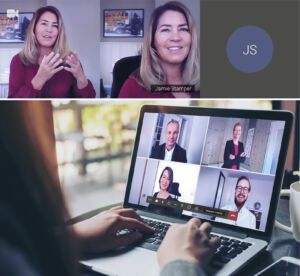Smart Working from Home Put to the Test during Lockdown

(5 min read)
When the worldwide Covid-19 pandemic made it feel like the earth quit turning, we had to work remotely every single day. In the process, we unintentionally learned some important things about ‘smart working’. I can share three lessons learned from a year and a half of field testing and a few more things to consider.
What Working at Home during Lockdown Taught Us
Under normal conditions, we were often found in our offices – or else spent a lot of time on the road: physically on site with customers, especially in critical project phases when it is a matter of design workshops, testing, training, or completing final checks and getting the systems up and running.
When the lockdown hit in the spring of 2020, we had to adjust to a new way of working. Suddenly, we needed to work completely mobile, without office days, without in person meetings and without business trips. Kitchen tables were converted into desks while guest rooms and conservatories were turned into home office workplaces. And, while we improvised and settled into the new ‘Covid normal’, we became ‘smart workers’ along the way.

‘Smart working’: If you google the term, you’ll find quite a few different definitions. The main idea is using modern technology to make the employees’ work more flexible and independent. The general idea is work becomes less strenuous and provides for quality of life. And there’s more: we’ve noticed that we can also concentrate better on what’s really important when we work ‘smart’: on new ideas, on our projects and, last but not least, on our colleagues.
The consequences of the ‘forced field test’ has demonstrated what is possible when we use what we have to our benefit. It protects the environment because unnecessary trips and flights are eliminated and travel costs for the company and our clients are also reduced. And, as individuals we can benefit. Creativity is unleashed by dovetailing work and life more strongly and organically for a more individual work-life-balance.
Three Lessons Learned From a Year and a Half of Field Testing:
1. There is no need for a fixed workplace
Over the past few years, we already worked remotely for certain tasks. And, most of us were working with laptops for more flexibility for years now, being able to travel to e.g. customers with every necessary document right on hand. Our developers from India, for example, were always connected remotely to us when a project status was discussed via video chat as project teams were always staffed internationally. The surprise was the ease with which suddenly everything worked purely digitally for everyone!
Covid proved one thing very clearly: Whether we complete a task on our own, together with colleagues or clients, or both, it primarily depends on the task. This is just as true for distributed work from many different remote workstations as it is for collaboration in the presence of the office. When you remove the fixed workplace, another important element of remote working is critical – reliable technology.
2. The right technology is key

We brought forward the rollout of Microsoft Teams, which had been planned anyway – just later in the year. With the collaboration tools MS Teams offers – video calls, shared calendar, workgroups, documents we can work on together – remote working under Covid conditions became ‘smart working’ practically from day one. OneDrive as a shared, virtual hard drive for teams has also proven to be a valuable tool.
Such web-based collaboration tools, which have been technically mature for some time and only require a certain Internet bandwidth, make the new flexibility of ‘smart working’ possible in the first place. From any location, and incidentally with much greater flexibility in working hours – including different time-zones. A short post in teams can be quickly placed at any time. Colleagues, anywhere in the world, can then pick up the thread when working again. However, this way of working needs the right corporate culture and communication.
3. Virtual communication requires mindfulness
It should no longer matter how, when and where a colleague has completed a task. Only the timely, creative result should count. If the common framework of the 9-to-5 workday in the office or the Monday- to-Thursday client on-site travel schedule is shifted, everyone must coordinate with each other on an ongoing basis: What will be the communication cadence? Who is available when? What are the guidelines of availability for project teams? What is the right form of communication – by teams? by e-mail? by comment in a shared document? by text? by phone call? With scheduled or ad-hoc meetings? And can we show grace when it becomes difficult — for example, because the children are doing homework in the same room?
In the best case – and fortunately we’ve managed to do this – the permanent synchronization leads to more mindfulness in dealing with each other, to more mutual respect. In many ways, we moved closer together during the pandemic, even though we were physically separated from each other.
 This was also because we became active as team members so as not to lose emotional contact with each other. We scheduled social video conferences: for the virtual after-work drink, the ‘Taco Tuesday’ meal, the virtual walk, or the online ‘Coffee Roulette’. We introduced our colleagues to our pets via webcam and shared photos on the Yammer platform. We were even willing to be more open in business meetings with noteworthy personal sharing.
This was also because we became active as team members so as not to lose emotional contact with each other. We scheduled social video conferences: for the virtual after-work drink, the ‘Taco Tuesday’ meal, the virtual walk, or the online ‘Coffee Roulette’. We introduced our colleagues to our pets via webcam and shared photos on the Yammer platform. We were even willing to be more open in business meetings with noteworthy personal sharing.
Smart Work is Hard Work, And It Can Result in Advantages
We have used the crisis to grow as a team. And, we have also realized: We have to keep improving our work processes, because there is no patented course of action for smart working.
In our growth, we’ve also learned that it is more than getting the ‘work tasks done’ while remote. Most of us still desire and need to co-locate for ‘Moments that Matter’ to build the foundation of trusted relationships, to build culture and community, to connect and network, to collaborate, to sometimes foster urgency and focus, and to complete some work tasks.
 Before the pandemic, many of our days at the office and/or on-site with our clients were defined by interaction. We looked forward to casual conversation, mentorship opportunities, and periodic, freewheeling chats inclusive of a stroll to the local coffeeshop or lunch cafe. Although we can do the tasks remote, sometimes our ‘smart work’ will need physical presence. We will learn to flex as we eventually surge out of this pandemic to a more balanced mind shift and flexible work location.
Before the pandemic, many of our days at the office and/or on-site with our clients were defined by interaction. We looked forward to casual conversation, mentorship opportunities, and periodic, freewheeling chats inclusive of a stroll to the local coffeeshop or lunch cafe. Although we can do the tasks remote, sometimes our ‘smart work’ will need physical presence. We will learn to flex as we eventually surge out of this pandemic to a more balanced mind shift and flexible work location.
We have created a truly agile company (Dieter Schoon, our Executive Vice President Global People)
If you are interested in more, read the stories of our heroes of (remote) working in our Annual Report 2020.